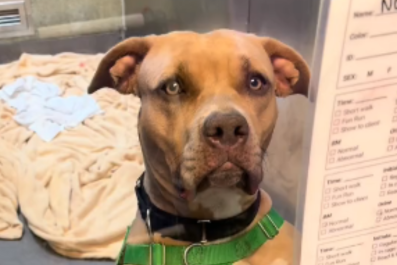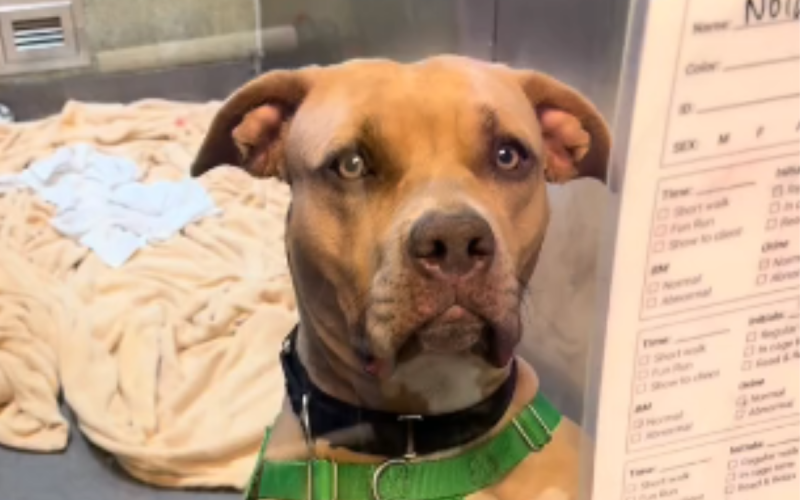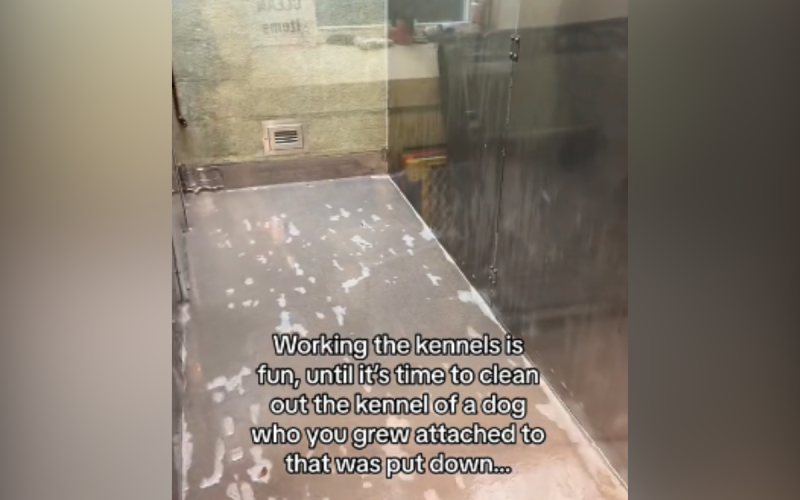
Shelter Worker Bonds With Stray, Heartbroken By What Happens Next
A Maryland shelter worker who formed a unique bond with a stray dog was left devastated after the most difficult of decisions was made.
As a child, Izaiah Perkins says he was "always drawn to animals." He told Newsweek: "They kept me company when I felt I didn't have many other ways to connect to the world."
Eager to give something back to his canine companions, Perkins landed a job with the Maryland SPCA in Baltimore. "The dogs remind me a lot of myself," he said. "They have good days and bad days, general preferences, and favorite people, just as we do. There's a sense of comfort when I go in and see them all, almost like I belong right there with them."
Perkins had only been working there a few months when he started to notice a three-year-old pit bull called Nola. "She was a stray that was found and handed in. She was there since before I started," he said.
Because of previous behavior issues, Perkins was not allowed to come into contact with Nola. Instead, his job was to clean her kennel, provide enrichment and hand out treats from her door.
"When I first met her I noticed how wide her eyes were, it's what drew me to her," he said. "She didn't wag her tail or come to greet me like most dogs at first, instead she stayed stiff with fear."

He quickly realized why she was only allowed contact with behavior staff at the shelter. Nola was struggling. The sound of other dogs in the shelter was setting off her anxiety leading to aggressive and panicked behavior. "Her wide eyes were a result of being under constant stress," he realized. "They almost never relaxed."
The busy environment of the shelter can be too much for many new dogs. According to one study published in the journal Physiology and Behavior, dogs entering the shelter system had three times the level of the stress hormone cortisol than those from standard households.
But this was worse. "Some dogs can adjust to the chaos of the kennels, but dogs like Nola seem to just deteriorate," Perkins said. "The behavior staff did everything they could, and displayed incredible patience and love with her."
Nola was becoming more erratic and unpredictable though. "One moment she'd seem okay and the next she'd lash out," Perkins said. "She became very dog aggressive, and at times displayed human aggression as well."
The sad reality was that Nola had "multiple" instances of biting people on her record. "She wasn't a bad dog, there are no bad dogs," Perkins said. "I truly believe that the environment was just too much for her and she lost herself."
Efforts to land Nola a foster stay also failed due to these issues. Eventually, an announcement was made. With Nola's mental health deteriorating badly and no sign of progress, she would be euthanized.
The decision was a difficult one for Perkins to take. More than most, he'd developed an attachment to Nola during his time talking to her through the glass.
"We would just stare at each other for up to ten minutes," he said. "There would be moments where I swore I broke through to her, where I could see her eyes soften just for a second, or a quick tail wag."
Perkins said he saw part of himself in her and the way she was struggling. "I know what it feels like to feel like you are slipping away," he said. "I always hoped she'd come around and surprise us with a happy ending. Always hoped I'd be able to see her finally relax and go to a home that will protect and love her, but the reality is that it doesn't always go that way."

Perkins spent time with Nola before she was put to sleep, filming one last video with his four-legged friend, which was posted to his TikTok @zskiie.
"You can see her trembling, her wide eyes and tucked tail," he said. "You can also tell that she is just a scared dog who deserves more than what life gave her." Perkins is keen to stress that the Maryland SPCA only uses euthanasia as a last resort for detrimental illness or violent and extreme behavior. Sadly, it had reached that point.
Once Nola had passed, Perkins was presented with one of the hardest parts of his job—returning to clean her now-empty kennel. "Part of me told myself she'd be back and she was just out on a walk, but reality quickly set in," he said. Perkins said he decided to post the video of Nola to "immortalize" her in some way.
"I try not to think too hard about the 'what ifs' because all we really have is the moment and I can't save them all," he said. "Her memory is alive in all of us... It's a shame she reached that point."
Perkins emphasizes that "for every sad story there are ten good ones" and that the shelter is home to lots of long-term stays that staff treat like "their own pets," but "sometimes making hard choices is necessary."
"The kennels and what goes on in them is the result of human negligence," he said. "Responsibility is the key to avoid putting dogs like Nola in stressful situations that will deteriorate their chances at a normal life."
